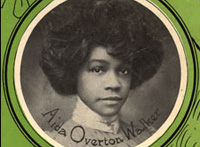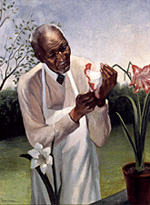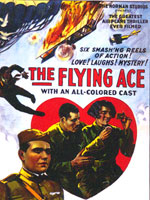Women's Suffrage: Burroughs's Article
Video 1:
- Photo. "Miss Nannie H. Burroughs." c.1922. New York Public Library Digital Gallery, Image ID: 1130371.
- Photo. "Mary McLeod Bethune, Ida B. Wells, Nannie Burroughs and other women at Baptist Women's gathering, Chicago." New York Public Library Digital Gallery, Image ID: 1920417.
- Cover and article header. The Crisis, August 1915. From the Modernist Journals Project, Brown University and the University of Tulsa.
- Article. Burroughs, N.H. "Black Women and Reform." The Crisis, August 1915. From the Modernist Journals Project, Brown University and the University of Tulsa.
- Photo. Oklahoma Federation of Colored Women banners, 1910.
Video 2:
- Photo. "Mamma and Her Jewels." In Golden Thoughts on Chastity and Procreation, J.W. Gibson. (Washington, DC: Austin Jenkins, 1903).
- Photo. "Engaged to be Married," in Golden Thoughts on Chastity and Procreation J.W. Gibson. (Washington, DC: Austin Jenkins, 1903).
- Photo. "Faithful to Duty," in Golden Thoughts on Chastity and Procreation J.W. Gibson. (Washington, DC: Austin Jenkins, 1903).
In the struggle for women's suffrage, how did African American women represent themselves? What goals did they have and how did they work to reach those goals? Reading an article published in the August 1915 issue of the NAACP newsletter The Crisis, TJ Boisseau finds that activist Nannie Helen Burroughs used several arguments in favor of suffrage for African American women. Burroughs emphasized women's roles as social "housekeepers" and their differences from African American men.
I have an interesting document, actually, about why black women need the vote. Black women are also using a kind of argument from expediency after 1900. By "expediency" I mean pragmatism, practical reasons. They’re not only arguing from justice—that this is what is right—although they retain that as well.
And I think that Nannie H. Burroughs's article, that is short and something that students could easily read, makes a profound point. Nannie Burroughs, whose mother was an emancipated slave, was one of the founders of the Women's Convention of the National Baptist Convention, which is a very important locale for the Southern black women's movement. She was a black women's club leader.
The clubs that women organized at the turn of the century are more than recreational and more than philanthropic even; and certainly for black women even when they're philanthropic, it's about uplifting the race. The National Association of Colored Women's motto becomes by the 1920s "Lifting as we Climb." And so there's an idea that anyone who achieves a certain level of middle-class respectability or economic stability in the black community has a responsibility to the entire black community. Women really took that message to heart and really saw their role change by 1900.
I would read this just to make sure that students take note of the particularities here. So this isn't a visual source, but it is a powerful textual source. It reads,
"When the ballot is put into the hands of the American woman the world is going to get a correct estimate of the Negro woman. It will find her a tower of strength of which poets have never sung, orators have never spoken, and scholars have never written. Because the black man does not know the value of the ballot, and has bartered and sold his most valuable possession, it is no evidence that the Negro woman will do the same."
And here what she's referring to is the common practice—or at least not uncommon practice—of black men who otherwise would have been beaten and possibly killed for voting, pragmatically taking money in order to vote for the Democratic party, the party of the South, the party of the Confederacy for a long time. She's critical of black men for that. I think as historians and as contemporary people we need to put that in some context, she's using this as a point of contention in order to draw a very different picture for black women. But I wouldn't want students to take away her criticism of black men, without understanding the context for it.
She goes on to say, "The Negro woman, therefore, needs the ballot to get back, by the wise use of it, what the Negro man has lost by the misuse of it. She needs to ransom her race. She carries the burdens of the Church, and of the school and bears a great deal more than her economic share in the home."
In a very short space of time she has identified key tensions between black men and black women and between blacks and whites. One is that black men are not allowed to have the kinds of industrial jobs that would provide a wage that can support a family. Black women, therefore, typically need to work outside the home for a wage. Which is something that is inimical, is opposite to the idea of the middle-class woman who does not engage in wage earning, or really deals with money in any way.
So she makes that point, but she also says that the black woman carries the burden of the church and the school. So at the same time she talks about black women have sort of double duties that are unique to black women but common to women in general, which is serving the church, serving the community, making sure that schooling and other services for children are there.
What she is doing is similar to white suffragists, is taking a popular convention of the moment and twisting it to serve her purposes. To say that regardless of what you feel about putting the vote in the hands of black people, here's how it will serve your interests. She's speaking a racist language. She concludes by saying, "The ballot, wisely used, will bring to her," the Negro woman, "the respect and protection that she needs. It is her weapon of moral defense." She has made her point loud and clear and gotten the attention of both white and black readers who then might debate, at least, the argument that she has brought to the fore. And, thereby, she has accomplished her aim—by putting suffrage smack in the middle of race relations and not just gender relations.



